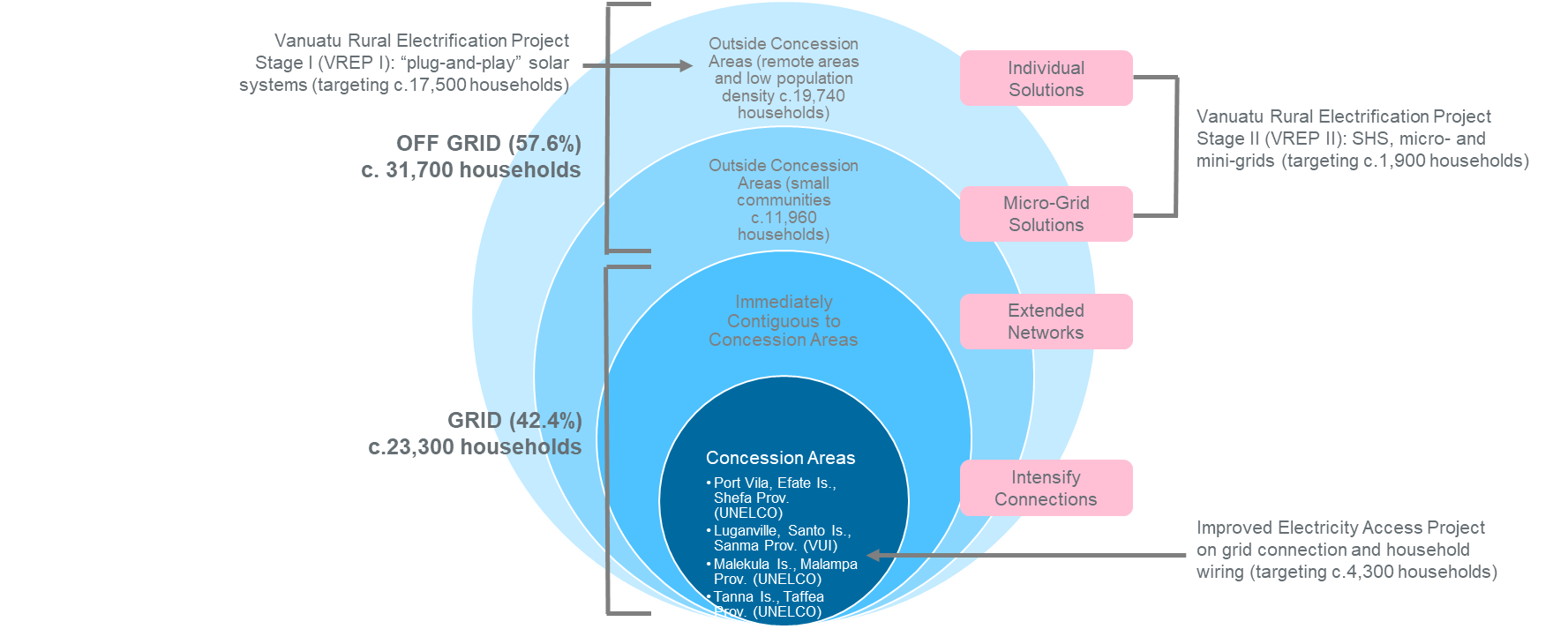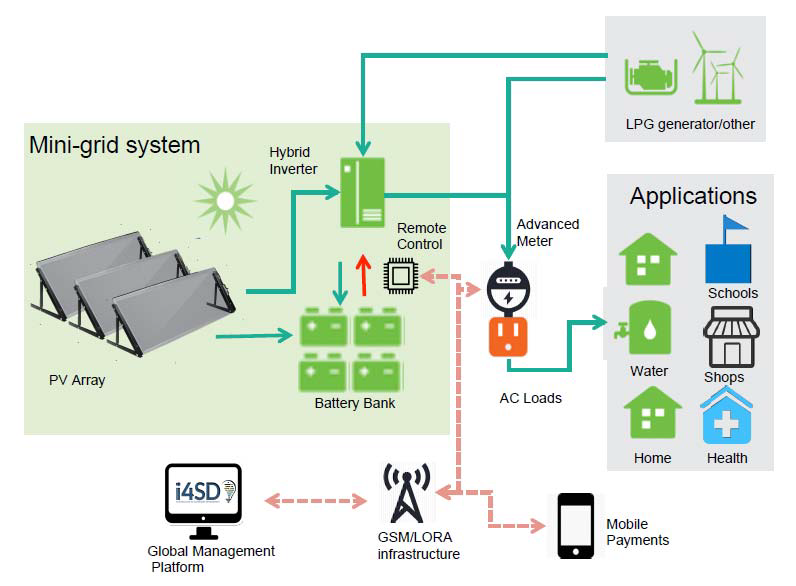The Project
The Government of Vanuatu, through the Department of Energy (DOE), is implementing a number of projects designed to support increased penetration of renewable energy and increased access to electricity services for rural households, public institutions and businesses located in the dispersed off-grid areas of Vanuatu. The World Bank and other development partners support and fund some of these projects.

Source: World Bank Project Appraisal Document 9 May 2017, paragraph 25
The Vanuatu Rural Electrification Project (VREP) is a key initiative to achieve these goals and is undertaken by DOE. DOE is defined as the initiative’s Owner. VREP is being undertaken in two stages:
- The first stage (VREP I) involves subsidizing ‘plug and play’ solar home systems (SHS) for remote dispersed rural households; and
- The second stage of VREP (VREP II) involves extending the subsidies to:
- larger technician-installed SHS and microgrids (component I); and
- mini-grids (component II) starting with the development of up to five (5) mini-grids1 in rural communities of Vanuatu (the Project).
A number of communities will be selected via an endorsed selection criteria and invited by DOE to elect to host and benefit from a mini-grid under component II VREP II. As such, this is a demand-driven initiative: communities are to choose to benefit from the mini-grid systems. The Project will thus be implemented in partnership between the DOE and the recipient communities of the mini-grids. The mini grids under component II VREP II are also intended to be developed within the Environmental and Social Management Framework and the Resettlement Policy Framework prepared for DOE by the World Bank in December 2016 as part of VREP. The mini grids under component II VREP II are further intended to be developed within the World Bank’s overall Environmental and Social Safeguard Policies.

A mini-grid is a stand-alone electricity generation source and distribution network. The envisaged mini-grids are small solar / diesel hybrid systems suiaccordionle for supplying the power needs of a small rural village where the energy consumption is quite limited (c.20 to 500 customers). Based on preliminary conducted simulations, the system size is generally expected to be in the range of 30 to 80 kilowatt-peak (kWp) catering for a village with a peak load in the range of 10 kW to 50 kW (in the evening) and a daily power consumption of 150 kW to 400 kWh/day, though larger-sized systems may also be constructed. Such hybrid systems typically involves solar photovoltaics (PV) arrays, a battery bank (able to store the equivalent of one day of expected demand) and/ or a diesel genset, preferably using biodiesel from locally produced crops such as copra, to meet peak demand and restart the system, as well as an inverter device to convert the direct current (DC) power generated by the PV arrays to the local alternating current (AC) distribution network itself.
Source: Innovations for Sustainable Development in Mini-Grids & Gender Equality, Inclusive Design, Better Development Outcomes, Key Issues and Potential actions, The World Bank group, Climate Investment Funds, ESMAP, February 2017
Project Proponent
Trama Tecno Ambiental (TTA) and its sub-consultants, is the Consultant selected as ‘Owner’s Engineer’ for the development and end-to-end delivery of the mini-grids under ‘Component II’ of the Vanuatu Rural Electrification Project – Stage II (VREP II) as set out in the related World Bank Project Appraisal Document dated May 2017 (the Project). DoE is the Project proponent and is responsible for the development of the mini grid Project with the support of the Consultant. Both DoE and the Consultant will lead and manage the stakeholder engagement activities documented under this Stakeholder Engagement Framework.
Stakeholder Engagement and Grievance Redress Mechanism Principles
The stakeholder engagement and grievance redress processes for the Project will be based on the following principles:
- Transparency and fairness:The process for grievance resolution shall be transparent, in harmony with the local culture, and in the appropriate language. It should explicitly assure potential users that the mechanism would not impede their access to other judicial or administrative remedies.
- Accessibility and cultural appropriateness: Every member of the community or groups should have access to the grievance procedure. Any individual or group that is directly or indirectly affected by the Project’s and its contractors’ activities, as well as those who may have an interest in the Project or the ability to influence its outcome, either positively or negatively, can raise a grievance. To allow all stakeholders to have access to the mechanism, the grievance redress mechanism will be publicized in the local languages (Bislama and English) of the community and communicated on to any vulnerable social groups in a clear and culturally appropriate manner to them.
- Meaningful Information:Meaningful information should be disclosed to the stakeholders to allow for active and informed engagement.
- Channels of communicationare to be open throughout the Project for addressing each grievance by persons trained and capable of receiving and communicating with vulnerable social groups in a sensitive manner.
- Written records: A Grievance Record Register is maintained, in a prescribed Form, as discussed in Section 6, which includes the tracking process of resolution.
- Dialogue and site visits: All grievances are warrant of a meaningful conversation (site visit investigation or telephone conversation) with the complainant (and potential other stakeholders of relevance), to verify the nature and severity of the complaint. It will also give a first-hand understanding of the nature of the concern.
- Incorporation of feedback:The feedback received to-date from the engagement and grievance redress process shall be incorporated into the Project design, and the same shall be reported back to the stakeholders in a clear and culturally appropriate manner to all, including vulnerable social groups. The aim being that all parties are agreeable to the resolution (and that this is recorded appropriately).
Proposed Stakeholder Engagement Activities
1.4.1. Project Site Criteria and Selection Process
The development of the Project includes, amongst other elements, the definition and implementation of the site criteria and selection process. This process is being carried out in three steps:
- Initial step: DOE in conjunction with the Vanuatu National Statistics Office (VNSO) drew a ‘Long List’ of communities potentially eligible to VREP II (completed in August 2019);
- First step: DOE, as the Project’s Owner and with support of the Consultant, will select the ‘Short List’ of communities invited to express interest in VREP II and propose potential hosting sites; and
- Second step: DOE, as the Project’s Owner and with the support of the Consultant, will assess whether the proposed sites can be developed under VREP II and will evaluate any potential environmental, social and resettlement related implications in order to minimize adverse impacts and enhance project benefits.
DOE drew a ‘community Long List’ of the communities located outside the concession areas. This was the initial step.
The construction of mini-grid systems in Vanuatu, as ‘Component 2’ of the Vanuatu Rural Electrification Project – Stage II (VREP II) set out in the Project Appraisal Document, defines the following initial criteria for selection of sites with potential to support a mini-grid:
- Community household numbers greater than 75 households; and
- Business and public institutions load greater than 50 percent of the total load.
VREP II Component 2 is expected to support electricity service provision to approximately 550 rural households, which equates to around 2,750 people, and public institutions and businesses.
The development of the Project will follow a stepped process:
- The first step of the Project will follow a top-down approach: DOE drew during the initial step a ‘Long List’ of communities that may be eligible to VREP II, by identifying all the Vanuatu communities that are not located with the existing electricity concessions; during the first step of VREP II, COM is due to endorse the selection criteria which are to be applied to the Long List of communities to define the selected communities (the ‘Short List’);
The second step of the Project will follow a bottom-up approach: eligible communities will be invited to express their interest in participating to the Project; communities interested in having a VREP II electricity system installed within their community will be asked to propose one or more site(s) on government or church land, with the commitment that the community can provide the land for generation equipment and access for construction and for distribution lines;
Stakeholder engagement activities during this second step will consist of inviting stakeholders to express their interest in the Project and to work on identifying and suggesting potential suiaccordionle sites;
- The third step of the Project will consist of evaluating the proposed sites from a technical, social and environmental standpoint;
- Stakeholder engagement activities during this third step will consist of consultation as part of an Environmental and Social Impact Assessment process commensurate to the anticipated risks and impacts of the mini-grid development